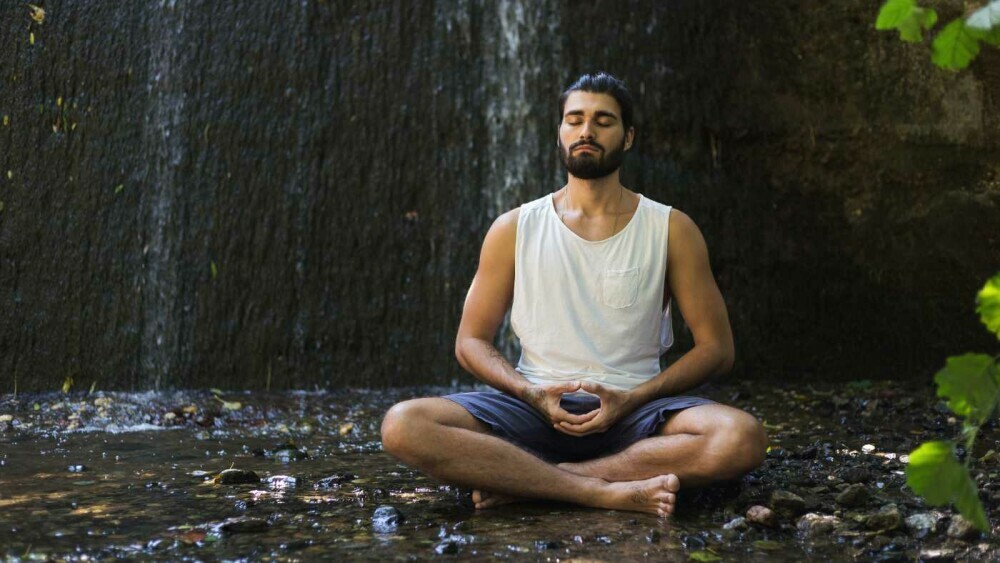Interested in the ancient wisdom of Zen meditation? Wondering how to discover inner peace and mindfulness through Zen techniques? You’re in the right place! This post is tailored for beginners like you. Let’s start by exploring how to approach Zen Meditation as a newcomer, and discover a diverse set of Zen meditation techniques for beginners.
Understanding Zen Practice
Zen is not just a set of techniques; it’s a way to transform how you experience things. Instead of focusing on theories, Zen encourages you to directly engage with the present moment. It’s about facing the now without getting caught up in your thinking. The goal is to have a deep, intuitive insight into life.
The heart of Zen is simplicity and straightforwardness. It means being fully present in the present without getting too attached or distracted. This direct experience is often called “seeing into your true nature” or “kensho” — a moment when you deeply realize things beyond just understanding them intellectually.
How to Start Zen Meditation as a Beginner
Starting Zen as a beginner is about being open, curious, and patient. Remember, it’s a journey, not a race. Approaching Zen Meditation with a beginner’s mind and a willingness to explore sets the stage for a meaningful and transformative journey. In the following three parts, we shall now look at specific Zen meditation techniques that you can bring into your daily life to live mindfully.
Part 1 – Basic Zen Meditation Techniques for Beginners
Ready to take your first steps on the Zen path? Let’s dive into the heart of the practice: basic meditation techniques for beginners. These simple yet powerful tools will guide you into the present moment, helping you cultivate inner peace and discover the quiet wisdom within.
Practice of Zazen (Seated Meditation)
Zazen, or seated meditation, is the heart of Zen practice. It’s not just about relaxing; it’s a way to connect with the core of who we are. The main idea of Zazen is to let go of all expectations and attachments. It’s about allowing your mind to naturally settle. Unlike some meditations that focus on specific things, Zazen is about being aware of the present moment without holding onto it. You observe your breath, body sensations, and what’s happening in your mind.
How to Practice Zazen Step-by-Step

- Posture: Find a quiet and comfy space. Sit on a cushion or chair with a straight back. Put your hands in a special shape, left hand on the right, with your thumbs lightly touching.
- Breath Awareness: Pay attention to your breath. Breathe naturally and notice how it feels as you breathe in and out.
- Eyes: Keep your eyes open, looking slightly down. This helps you stay alert and not daydream.
- Mindfulness: Be aware of your thoughts, sensations, and feelings. Instead of getting caught up in them, just watch and let them go without judging.
- Returning to the Breath: When your mind wanders, gently bring it back to your breath. Your breath is like an anchor to the present moment.
- Duration: Start with short sessions and make them longer as you get more comfortable. It’s about the quality of your practice more than the quantity.
Benefits of Regular Zazen Practice
- Clarity & Concentration: Zazen helps you think clearly and stay focused, so you can handle life’s challenges calmly.
- Stress Reduction: Doing Zazen regularly can lower stress levels, making you feel more peaceful and resilient.
- Self-Discovery: Through ongoing practice, you might learn more about how your mind works, gaining a deeper understanding of yourself.
- Emotional Balance: Zazen teaches you to be aware of your emotions without reacting impulsively. This lets you respond wisely to situations.
- Spiritual Growth: For many, Zazen is a journey that leads to profound insights, self-realization, and a feeling of connection with everything in existence.
Practice of Kinhin (Walking Meditation)
Mindful walking, known as Kinhin in Zen practice, is a way of blending meditation with movement. It’s like taking meditation with you as you walk. Usually done between sitting meditation sessions, Kinhin helps keep the calm and focused state of mind going.
How to Practice Walking Meditation

- Posture: Start by standing in a relaxed yet alert way. Hold your hands in a specific position, like putting your right fist in your left open palm, at chest level.
- Breath Awareness: Connect with your breath, just like in sitting meditation. Breathe naturally and stay focused on the present moment.
- Starting: When the leader signals, take a slow step forward with your left foot. Match your pace with your breath—inhale as you lift your foot, exhale as it touches the ground.
- Gaze: Keep your eyes open, looking gently at the floor a few feet ahead. This helps you stay aware of both yourself and your surroundings.
- Mindfulness in Movement: Stay mindful as you walk. Pay full attention to each step, feeling the sensations in your feet and the movement of your body.
- Turning: When you reach the end of your walking path, take a moment to pause, breathe, and turn around mindfully. Start walking in a new direction.
- Conclusion: Kinhin usually ends with everyone forming a circle and bowing to each other as a way of saying thanks.
Benefits of Walking Meditation:
- Grounding & Centering: The slow pace of mindful walking helps you feel stable and centered.
- Physical Relaxation: Walking mindfully can ease physical tension, making your body feel more comfortable and relaxed.
- Mind & Body Together: Mindful walking shows that meditation isn’t just sitting still; it can be part of every action you take.
- Transition from Sitting Meditation: Mindful walking smoothly moves you from sitting to walking, keeping your meditative state while gently changing what you’re doing.
- Community Connection: Doing mindful walking together in a group makes you feel connected and mindful as a community.
Part 2: Exploring Deeper Zen Meditation Techniques
Ready to take your Zen journey to the next level? In Part 2, we’ll explore advanced practices that go beyond the basics. Get ready for mind-expanding experiences, thought-provoking questions, and the possibility of sudden moments of enlightenment.
Practice of Shikantaza & Silent Illumination (Just Sitting Meditation)
Just Sitting Meditation, also known as Shikantaza or Silent Illumination, is a way of sitting and being fully aware without focusing on anything specific. It comes from traditions like Soto Zen, Chan, and Linji, encouraging direct engagement with the present moment without getting caught up in thoughts.

How to Practice Shikantaza (Just Sitting Meditation)
- Posture: Sit comfortably on a cushion or chair, keep your back straight, hands in a mudra, and eyes open with a gentle gaze.
- Intention: Instead of focusing on something, like in other meditations, the goal here is just to be present. Let thoughts and feelings come and go without getting stuck on them.
- Breath Awareness: While you can pay attention to your breath, it’s not the main focus. Let your breath flow naturally as you stay aware of everything happening around you.
- Non-Striving: Don’t have a specific goal. Just Sitting is not about reaching a certain state; it’s about fully experiencing and embracing whatever comes up.
- Gentle Redirecting: If your mind wanders, gently bring it back to the present. No need to force it into stillness; let thoughts pass naturally.
Benefits of Shikantaza (Just Sitting Meditation)
- Direct Insight: Just Sitting helps you directly experience reality without getting too caught up in thinking. You might discover insights beyond what you intellectually understand.
- Embracing Impermanence: This practice lets you deeply understand that everything changes. Accepting this impermanence can bring a profound sense of peace.
- Transcending Duality: By letting go of fixed ideas, Just Sitting opens the door to an experience beyond opposites—beyond good or bad, self or other.
- Natural Mindfulness: Just Sitting encourages a kind of mindfulness that includes everything without picking and choosing. It embraces sounds, sensations, and thoughts without judging them.
- Integration into Daily Life: The openness and receptiveness you develop in Just Sitting can extend into your daily activities, influencing how you approach and engage with them.
Understanding Koans & Hua Tou Technique – The Puzzle of Zen
Zen has unique meditation techniques called Koans and Hua Tou. These involve thinking about statements or questions that seem contradictory. The goal is to go beyond regular thinking and have a direct, intuitive understanding of truth. Koans are linked with the Rinzai tradition, while Hua Tou is connected to the Linji tradition.

How to Work with Zen Puzzles
- Choosing a Puzzle: A Zen teacher usually gives a specific Koan or Hua Tou based on the practitioner’s readiness. The chosen puzzle becomes the focus of meditation.
- Silent Inquiry: Instead of thinking analytically, you silently think about the puzzle. It’s not about finding a logical answer; it’s about letting the question sink in without trying to solve it.
- Unanswerable Nature: Koans are intentionally puzzling. The goal isn’t to solve them with your mind but to break free from regular thinking and gain direct insight.
- Beyond Regular Understanding: These puzzles often involve questions that don’t have logical answers. This pushes you to go beyond regular thinking and tap into a more intuitive, non-logical way of understanding.
- Patient Inquiry: Working with Koans and Hua Tou takes time and patience. It’s not about quickly finding an answer but about deeply thinking about the puzzle over a long period.
How Zen Puzzles Bring Insights
- Breaking Dualistic Thinking: Koans and Hua Tou aim to break down thinking into opposites by giving questions that can’t be solved with regular logic. This opens the door to understanding reality in a direct, non-opposite way.
- Direct Experience: Working with these puzzles encourages you to move past regular understanding and directly experience the truth they point to.
- Transcending Language: Koans often use language that goes beyond regular words and ideas. By dealing with these puzzles, you try to go past language-based thinking and touch a deeper, wordless awareness.
- Revealing Insights: As you continue to think about a Koan or Hua Tou, you might have realizations. These aren’t regular thoughts but intuitive understandings that come from directly encountering the puzzle’s essence.
- In Daily Life: The insights from working with these puzzles aren’t just for meditation. They can affect how you deal with everyday life.
Understanding Chanting & Mantra Meditation in Zen
Chanting and mantra meditation are ancient practices used in Zen Buddhism to help focus the mind, improve concentration, and make meditation deeper.
- Chanting: In Zen, chanting means saying sacred texts or verses rhythmically. When everyone chants together, it creates a calm feeling and a sense of togetherness.
- Mantra Meditation: Mantras are special sounds or words repeated silently or out loud. In Zen, repeating mantras helps you concentrate, calm your mind, and become more aware.
How to Practice Chanting & Mantra Meditation:

- Choosing Chants or Mantras: Pick chants or mantras that mean something to you or are commonly used in Zen. Some examples are the Heart Sutra, Lotus Sutra, or names of Bodhisattvas.
- Setting Intentions: Before you start chanting or repeating a mantra, decide why you’re doing it. It could be to find inner peace, show kindness, or simply quiet your mind.
- Repeating Mindfully: Whether you’re chanting with a group or doing mantra meditation alone, pay attention to the rhythm and meaning of each word. Repeat them with awareness, feeling the sound inside you.
- Posture & Breath: Sit comfortably, like you would in regular meditation. Match your chanting or mantra repetition with your breath to create a peaceful flow of sound and breath.
- Quiet Repetition: If you’re silently repeating a mantra, bring it into your mind with each breath. Let the repetition become a soothing, meditative rhythm.
Benefits of Adding Sound to Zen Practice:
- Concentration: Chanting and mantra meditation gives your mind a point to focus on, helping to calm it down and reduce thinking. This makes meditation deeper.
- Vibrational Harmony: Sounds have a gentle yet strong effect on your body and mind. Chanting and mantras create a feeling of harmony inside, bringing peace.
- Mindfulness Growth: The rhythmic aspect of chanting or mantra repetition boosts mindfulness. It helps you be aware of the present moment by creating a gap between thoughts.
- Community & Togetherness: Chanting, especially when done as a group in Zen, makes you feel part of a community with a shared purpose. The combined sound makes a sacred space that goes beyond individual experiences.
- Energy Transformation: Purposeful sound use in Zen is thought to change mental and emotional energy. It can be a way to release emotions and create positive feelings.
Understanding Hitotsu Zendo (One-Stroke Meditation)
Hitotsu Zendo, also known as One-Stroke Meditation, is a Zen practice that focuses on the immediate and direct experience of enlightenment. It goes against the idea that enlightenment is a gradual journey, suggesting that it can happen in a single moment of deep understanding.
- Sudden Enlightenment: Hitotsu Zendo is all about sudden enlightenment or “kensho.” It challenges the idea that reaching enlightenment takes a long time, saying it can happen right now.
- Non-Dualistic Experience: This practice encourages experiencing reality without separating things into “me” and “other” or “subject” and “object.”
Doing the One-Stroke Technique in Zen Meditation

- Simple Practice: Hitotsu Zendo keeps meditation simple. Instead of using complex methods, you focus on one direct stroke of awareness, cutting through layers of thoughts.
- Immediate Recognition: The one-stroke technique is about immediately recognizing your true self. You don’t need to understand it with your mind; it’s something you feel and realize inside.
- Letting Go of Effort: Unlike some meditations that need a lot of effort, Hitotsu Zendo is about relaxing. It’s not about trying hard to reach a certain state; it’s about being natural.
- Present-Moment Awareness: You concentrate on being fully present now, without getting caught up in thoughts about the past or future. This fits with the Zen idea that enlightenment is available to you right here, right now.
Discovering the Simplicity & Depth of Hitotsu Zendo
- Beyond Complexity: Hitotsu Zendo makes meditation less complicated. It shows that meditation is simple and can be done by anyone, no matter their background or experience.
- Direct Insight: Because it’s simple, Hitotsu Zendo allows you to directly understand reality. You might experience a big shift in how you see things, going beyond regular thinking.
- Integration into Daily Life: Hitotsu Zendo is not just for meditation times. It wants you to bring this simple approach into everything you do every day, keeping you in a state of awakened awareness.
- Embracing the Ordinary: Hitotsu Zendo says enlightenment isn’t only for special moments. It’s in everyday things, and it invites you to see the sacred in regular, everyday life.
Part 3: Bringing Zen into Your Everyday Life
Bringing Zen into your everyday life means taking the mindfulness you practice in formal meditation and applying it to all the different things you do each day. When you bring Zen into your work, think about the teachings, and handle daily situations with Zen ideas in mind, you make mindfulness a natural part of everything you do.

Samu (Work Practice) – Making Daily Tasks a Meditation
Samu, or work practice, is a way to bring Zen mindfulness into your everyday activities. It means doing tasks with full attention and treating each action as a form of meditation.
- Mindful Engagement: Approach your daily tasks with mindfulness. Whether it’s doing chores, walking, or working, give your full attention to the activity.
- Present-Moment Awareness: While doing Samu, focus on the present moment. Feel the sensations, notice movements, and pay attention to details without getting lost in thoughts.
- Transforming Everyday Activities: See the potential for change in simple activities. By being mindful, routine tasks become chances for self-discovery and inner peace.
- Applying Zazen Principles: Bring Zazen principles like keeping a straight posture and being fully present into your work. This helps connect formal meditation with your daily life.
Teisho (Dharma Talk) – Learning and Reflecting on Teachings
Teisho means a Dharma talk, where a Zen teacher shares important teachings. To include Teisho in your practice, listen to and think about these teachings.
- Listening with Openness: When listening to a Teisho, have an open mind and heart. Let the teachings go beyond just understanding them and connect with your own experiences.
- Reflective Contemplation: After a Dharma talk, take time to think about it. Consider how the teachings relate to your life and meditation.
- Journaling: Write down your thoughts and insights in a journal. This helps you understand more and gives you a record of your personal growth.
- Discussion & Community: Talk to fellow practitioners about the teachings. Sharing insights builds a supportive community that helps everyone understand better.
Cultivating the Mind of Fusho (Unborn) in Daily Encounters
Cultivating the mind of Fusho, or the Unborn, means approaching daily interactions with open awareness and no attachment.
- Letting Go of Labels: Forget labels and judgments when dealing with people and situations. Look at each encounter with fresh eyes, without carrying past opinions.
- Non-Attachment: Don’t get attached to specific outcomes or expectations. Have a mindset that allows for spontaneity and openness in your interactions.
- Embracing Impermanence: Understand that every moment is temporary. The mind of Fusho accepts the constant changes in life without holding onto fixed ideas.
- Mindful Communication: Speak and listen with mindfulness. Be aware of your words, tone, and the spaces between words to communicate clearly and compassionately.
- Applying Zen Principles: Use Zen principles like mindfulness and presence in your daily interactions. See each encounter as a chance to practice being fully present and engaged.
Conclusion: Start Your Zen Meditation Journey
Starting a Zen meditation journey is like an open invitation to explore the vast world of mindfulness and enlightenment. Starting from basic practices like Zazen and Kinhin to more profound ones like Shikantaza, Koans, and immersive retreats, Zen meditation offers various ways to meditate.
You can also bring Zen into your daily life through practices like Samu, Teisho, and Hitotsu Zendo, making mindfulness a natural part of everything you do. The Zen path isn’t about reaching a faraway goal; it’s about experiencing the journey with an open mind and being fully present. Whether you’re just starting or going deeper into Zen meditation, every moment is a chance for awakening.
Ready to Transform Your Life with Meditation? If you’re looking for support in making meditation a daily habit, take a look at the linked meditation program that I found helpful.

